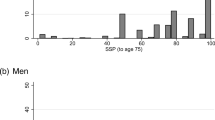Abstract
This paper introduces a model of retirement wealth choice. Reservation wealth is defined as the level of wealth at which an individual is indifferent between retiring and not retiring. Economic theory is used to generate hypotheses concerning how an individual's characteristics determine his or her reservation wealth. An econometric strategy is outlined for estimating these determinants, given that reservation wealth is not directly observed. This strategy is then employed using the 1992 Survey of Consumer Finances. The findings imply that individuals respond fairly conservatively, with respect to their retirement planning, to changes in their income. It is also found that married men and women choose their reservation wealth in very different ways.
Similar content being viewed by others
References
Ashenfelter, O., & Heckman, J. (1973). Estimating labor supply functions. In G. Cain and H. Watts (eds.). Income Maintenance and Labor Supply. New York: Academic Press.
Bernheim, B.D. (1996). The Merril Lynch baby boom retirement index. Stanford, CA: Stanford University and Merril Lynch & Co., Inc.
Burkhauser, R. (1979). The pension acceptance decision of older workers. Journal of Human Resources, 14(1), 63–75.
Burtless, G., & Moffit, R.A. (1985). The joint choice of retirement age and post retirement hours of work. Journal of Labor Economics, 3(2), 209–236.
Diamond, P.A., & Hausman, J.A. (1984). Individual retirement and savings behavior. Journal of Public Economics, 23(2), 81–114.
Dooley, M. D. (1982). Labor supply and fertility of married women: an analysis with grouped and individual data from the 1970 U.S. Census. Journal of Human Resources, 17(4), 499–532.
Efron, B., & Tibshirani, R. J. (1993). An introduction to the bootstrap. New York: Chapman and Hall.
Fields, G., & Mitchell, O. (1984). Retirement, pensions and Social Security. Cambridge, MA: The MIT Press.
Hatcher, C.B. (1997). A model of desired wealth at retirement. Financial Counseling and Planning, 8(1), 57–64.
Heckman, J. (1974). Shadow prices, market wages, and labor supply. Econometrica, 42(4), 679–694.
Hira, T. K., Fitzsimmons, V. S., Hafstrom, J. L., & Bauer, J. W. (1993). Factors associ Charles B. Hatcher 187 ated with expectation of household's future resources. Journal of Family and Economic Issues, 14, 237–256.
Jianakoplos, N., Menchik, P. L., & Irvine, F. O. (1989). Using panel data to assess the bias in cross-sectional differences of life-cycle changes in the level and composition of household wealth. In R. Lipsey and H. Tice (eds.), The Measurement of saving, investment and wealth: Studies in income and wealth: Vol. 52. National Bureau of Economic Research Conference on Research in Income and Wealth. Chicago: The University of Chicago Press.
Kao, Y., Hong, G., & Widdows, R. (1997). Bequest expectations: evidence from the Survey of Consumer Finances. Journal of Family and Economic Issues, 18, 357–377.
Kurz, M. (1984). Capital accumulation and the characteristics of private intergenerational transfers. Economica, 51(1), 1–22.
Menchik, P., & David, M. (1983). Income distribution, lifetime savings, and bequests. American Economic Review, 73(4) 672–690.
Montalto, C. P., & Yuh, Y. (1998). Estimating nonlinear models with multiply imputed data. Financial Counseling and Planning, 10(1), 97–101.
Moore, J.F., & Mitchell, O.S. (1997). Projected retirement wealth and savings adequacy in the health and retirement study (Pension Research Council Working Paper 98-1). Philadelphia, PA: University of Pennsylvania, the Wharton School.
Quinn, J. F. (1977). Microeconomic determinants of early retirement. Journal of Human Resources, 12(3) 329–347.
Rubin, D. (1987). Multiple imputation for non-response in surveys. New York: John Wiley and Sons.
Sammartino, F. (1987). The effect of health on retirement. Social Security Bulletin, 50(2), 31–47.
U. S. Bureau of Labor Statistics (1992). Employment and earnings. Washington, D.C.: Author.
Varian, H.R. (1993). Microeconomic Analysis (3rd ed.). New York: W.W. Norton.
Yuh, Y., Montalto, C.P., & Hanna, S. (1998). Are Americans prepared for retirement? Financial Counseling and Planning, 9(1), 1–12.
Author information
Authors and Affiliations
Rights and permissions
About this article
Cite this article
Hatcher, C.B. Wealth, Reservation Wealth, and the Decision to Retire. Journal of Family and Economic Issues 23, 167–187 (2002). https://doi.org/10.1023/A:1015738717484
Issue Date:
DOI: https://doi.org/10.1023/A:1015738717484




